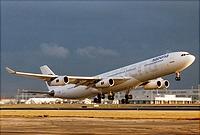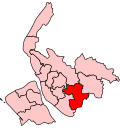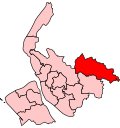Reptiles are
tetrapods and
amniotes, animals whose
embryos are surrounded by an amniotic
membrane, and members of the class
Sauropsida. Today they are represented by four surviving
orders:
Modern reptiles inhabit every
continent except for
Antarctica, although their main distribution comprises the
tropics and
subtropics. Though all
cellular metabolism produces some
heat, most modern
species of reptiles do not generate enough to maintain a constant
body temperature and are thus referred to as "
cold-blooded" or ectothermic (the
Leatherback Sea Turtle might be an exception, see also
gigantothermy). Instead, they rely on gathering and losing heat from the
environment to regulate their internal temperature, e.g, by moving between
sun and shade, or by preferential
circulation — moving warmed
blood into the body core, while pushing cool blood to the periphery. In their natural
habitats, most species are adept at this, and can usually maintain core body temperatures within a fairly narrow range. Reptiles are thick-skinned; unlike
amphibians, they do not need to absorb water. While this lack of adequate internal heating imposes costs relative to temperature regulation through
behavior, it also provides a large benefit by allowing reptiles to survive on much less
food than comparably-sized mammals and birds, who burn much of their food for warmth. While warm-blooded animals move faster in general, an attacking lizard, snake or crocodile moves very quickly.
Except for a few members of the Testudines, all reptiles are covered by scales.
Most reptile species are
oviparous (egg-laying). Many species of squamates, however, are capable of giving live birth. This is achieved, either through
ovoviviparity (egg retention), or
viviparity (offspring born without use of
calcified eggs). Many of the viviparous species feed their
fetuses through various forms of
placenta analogous to those of mammals (Pianka & Vitt, 2003 pgs: 116-118). They often provide considerable initial care for their
hatchlings.
Anapsida Diapsida Reptilia
Laurenti, 1768 Crocodilia (
crocodiles,
gharials,
caimans and
alligators): 23 species
Sphenodontia (
tuataras from
New Zealand): 2 species
Squamata (
lizards,
snakes and
amphisbaenids ("worm-lizards")): approximately 7,900 species
Testudines (
turtles and
tortoises): approximately 300 species
Classification of reptiles From the classical standpoint, reptiles included all the
amniotes except
birds and
mammals. Thus reptiles were defined as the set of
animals that includes
crocodiles,
alligators,
tuatara,
lizards,
snakes,
amphisbaenians and
turtles, grouped together as the class
Reptilia (Latin
repere, "to creep"). This is still the usual definition of the term. However, in recent years, many taxonomists have begun to insist that taxa should be
monophyletic, that is, groups should include all descendants of a particular form. The reptiles as defined above would be
paraphyletic, since they exclude both birds and mammals, although these also developed from the original reptile. Colin Tudge writes:
The terms "Sauropsida" ("Lizard Faces") and "
Theropsida" ("Beast Faces") were coined in
1916 by
E.S. Goodrich to distinguish between lizards, birds, and their relatives on one hand (Sauropsida) and
mammals and their extinct relatives (Theropsida) on the other. This division is supported by the nature of the hearts and blood vessels in each group, and other features such as the structure of the forebrain. According to Goodrich both lineages evolved from an earlier stem group, the Protosauria ("First Lizards") which included some
Paleozoic amphibians as well as early reptiles.
In 1956
D.M.S. Watson observed that the first two groups diverged very early in reptilian history, and so he divided Goodrich's Protosauria among them. He also reinterpreted the Sauropsida and Theropsida to exclude birds and mammals respectively. Thus his Sauropsida included
Procolophonia,
Eosuchia,
Millerosauria,
Chelonia (turtles),
Squamata (lizards and snakes),
Rhynchocephalia,
Crocodilia, "
thecodonts" (
paraphyletic basal Archosauria), non-
avian dinosaurs,
pterosaurs,
ichthyosaurs, and
sauropyterygians.
This classification supplemented, but was never as popular as, the classification of the reptiles (according to
Romer's classic
Vertebrate Paleontology) into four subclasses according to the positioning of
temporal fenestrae, openings in the sides of the skull behind the eyes. Those divisions were:
All of the above but Synapsida fall under Sauropsida.
Anapsida - no fenestrae
Synapsida - one low fenestra (no longer considered true reptiles)
Euryapsida - one high fenestra (now included within Diapsida)
Diapsida - two fenestrae
Taxonomy Phylogeny Hylonomus is the oldest-known reptile, and was about 8 to 12 inches (20 to 30 cm) long.
Westlothiana has been suggested as the oldest reptile, but is for the moment considered to be more related to amphibians than
amniotes.
Petrolacosaurus and
Mesosaurus are other examples. The earliest reptiles were found in the swamp forests of the
Carboniferous, but were largely overshadowed by bigger
labyrinthodont amphibians such as
Proterogynrius. It was only after the small ice age at the end of the Carboniferous that the reptiles grew to big sizes, producing species such as
Edaphosaurus and
Dimetrodon.
The first true "reptiles" (Sauropsids) are categorized as
Anapsids, having a solid skull with holes only for nose, eyes, spinal cord, etc. Turtles are believed by some to be surviving Anapsids, as they also share this skull structure; but this point has become contentious lately, with some arguing that turtles reverted to this primitive state in order to improve their armor. Both sides have strong evidence, and the conflict has yet to be resolved.
Shortly after the first reptiles, two branches split off, one leading to the Anapsids, which did not develop holes in their skulls. The other group,
Diapsida, possessed a pair of holes in their skulls behind the eyes, along with a second pair located higher on the skull. The Diapsida split yet again into two lineages, the
lepidosaurs (which contain modern snakes, lizards and tuataras, as well as, debatably, the extinct sea reptiles of the Mesozoic) and the
archosaurs (today represented by only
crocodilians and
birds, but also containing
pterosaurs and
dinosaurs).
The earliest, solid-skulled
amniotes also gave rise to a separate line, the
Synapsida.
Synapsids developed a pair of holes in their skulls behind the eyes (similar to the diapsids), which were used to both lighten the skull and increase the space for jaw muscles. The synapsids eventually evolved into
mammals, and are often referred to as mammal-like reptiles, though they are not true members of Sauropsida. (A preferable term is "stem-mammals".)
Evolution of the reptiles Systems All reptiles have closed circulation via a three-chamber
heart consisting of two
atria and one, variably-partitioned
ventricle. There is usually one pair of aortic arches. In spite of this, because of the fluid dynamics of blood flow through the heart, there is little mixing of
oxygenated and deoxygenated blood in the three-chamber heart. Furthermore, the blood flow can be altered to shunt either deoxygenated blood to the body or oxygenated blood to the lungs, which gives the animal greater control over its blood flow, allowing more effective thermoregulation and longer diving times for aquatic species. There are some interesting exceptions among reptiles. For instance,
crocodilians have an anatomically four-chambered heart that is capable of becoming a functionally three-chamber heart during dives (Mazzotti, 1989 pg 47). Also, it has been discovered that some snake and lizard species (e.g., monitor lizards and pythons) have three-chamber hearts that become functional four-chamber hearts during contraction. This is made possible by a muscular ridge that subdivides the ventricle during
ventricular diastole and completely divides it during
ventricular systole. Because of this ridge, some of these
squamates are capable of producing ventricular pressure differentials that are equivalent to those seen in mammalian and avian hearts (Wang et al, 2003).
Circulatory All reptiles breathe using lungs. Aquatic
turtles have developed more permeable skin, and even
gills in their anal region, for some species (Orenstein, 2001). Even with these adaptations, breathing is never fully accomplished without
lungs. Lung ventilation is accomplished differently in each main reptile group. In
squamates the lungs are ventilated almost exclusively by the axial musculature. This is also the same musculature that is used during locomotion. Because of this constraint, most squamates are forced to hold their breath during intense runs. Some, however, have found a way around it. Varanids, and a few other lizard species, employ
buccal pumping as a complement to their normal "axial breathing." This allows the animals to completely fill their lungs during intense locomotion, and thus remain aerobically active for a long time. Tegu lizards are known to possess a proto-
diaphragm, which separates the pulmonary cavity from the visceral cavity. While not actually capable of movement, it does allow for greater lung inflation, by taking the weight of the viscera off the lungs (Klein et al, 2003).
Crocodilians actually have a muscular diaphragm that is analogous to the mammalian diaphragm. The difference is that the muscles for the crocodilian diaphragm pull the pubis (part of the pelvis, which is movable in crocodilians) back, which brings the liver down, thus freeing space for the lungs to expand. This type of diaphragmatic setup has been referred to as the "hepatic piston."
How
Turtles & Tortoises breathe has been the subject of much study. To date, only a few species have been studied thoroughly enough to get an idea of how turtles do it. The results indicate that turtles & tortoises have found a variety of solutions to this problem. The problem is that most turtle shells are rigid and do not allow for the type of expansion and contraction that other amniotes use to ventilate their lungs. Some turtles such as the Indian flapshell (
Lissemys punctata) have a sheet of muscle that envelopes the lungs. When it contracts, the turtle can exhale. When at rest, the turtle can retract the limbs into the body cavity and force air out of the lungs. When the turtle protracts its limbs, the pressure inside the lungs is reduced, and the turtle can suck air in. Turtle lungs are attached to the inside of the top of the shell (carapace), with the bottom of the lungs attached (via connective tissue) to the rest of the viscera. By using a series of special muscles (roughly equivalent to a
diaphragm), turtles are capable of pushing their viscera up and down, resulting in effective respiration, since many of these muscles have attachment points in conjunction with their forelimbs (indeed, many of the muscles expand into the limb pockets during contraction). Breathing during locomotion has been studied in three species, and they show different patterns. Adult female green sea turtles do not breathe as they crutch along their nesting beaches. They hold their breath during terrestrial locomotion and breathe in bouts as they rest. North American box turtles breathe continuously during locomotion, and the ventilation cycle is not coordinated with the limb movements (Landberg et al., 2003). They are probably using their abdominal muscles to breathe during locomotion. The last species to have been studied is red-eared sliders, which also breathe during locomotion, but they had smaller breaths during locomotion than during small pauses between locomotor bouts, indicating that there may be mechanical interference between the limb movements and the breathing apparatus. Box turtles have also been observed to breathe while completely sealed up inside their shells (ibid).
Most reptiles lack a
secondary palate, meaning that they must hold their breath while swallowing. Crocodilians have evolved a bony secondary palate that allows them to continue breathing while remaining submerged (and protect their brains from getting kicked in by struggling prey). Skinks (family Scincidae) also have evolved a bony secondary palate, to varying degrees. Snakes took a different approach and extended their trachea instead. Their tracheal extension sticks out like a fleshy straw, and allows these animals to swallow large prey without suffering from asphyxiation.
Also, crocodiles are known to cry while eating. Many myths and folklore have grown around this astonishing fact, such as that the crocodile feels guilty for eating, but in truth, the crocodile cries to release fluid from its body, to make room for oxygen. This is also due to the fact that the crocodile's nasal cavity (nose) is exceptionally small.
Respiratory Excretion is performed mainly by two small
kidneys. In diapsids
uric acid is the main
nitrogenous waste product; turtles, like
mammals, mainly excrete
urea. Unlike the kidneys of mammals and birds, reptile kidneys are unable to produce liquid urine more concentrated than their body fluid. This is because they lack a specialized structure present in the
nephrons of birds and mammals, called a
Loop of Henle. Because of this, many reptiles use the
colon and
cloaca to aid in the
reabsorption of water. Some are also able to take up water stored in the
bladder. Excess salts are also excreted by nasal and lingual salt-glands in some reptiles.
 Excretory
Excretory The reptilian nervous system contains the same basic part of the
amphibian brain, but the reptile
cerebrum and
cerebellum are slightly larger. Most typical sense organs are well developed with certain exceptions most notably the snakes lack of external ears (middle and inner ears are present). All reptilians have advanced visual depth perception compared to other animals. There are twelve pairs of
cranial nerves.
[1] Nervous Most reptiles reproduce sexually. All male reptiles except turtles and tortoises have a twin tube-like sexual organ called the
hemipenes. Turtles and tortoises have a single penis. All testudines lay eggs, none are live bearing as some lizards and snakes are. All reproductive activity occurs with the cloaca, the single exit/entrance at the base of the tail where waste and reproduction happens.
Asexual reproduction has been identified in
squamates in six families of lizards and one snake. In some species of squamates, a population of females are able to produce a unisexual diploid clone of the mother. This asexual reproduction called
parthenogenesis occurs in several species of
gecko, and is particularly widespread in the
teiids (especially
Aspidocelis) and
lacertids (
Lacerta) In captivity
Komodo dragons (varanidae) have reproduced by parthenogenesis.
Parthenogenetic species are also suspected to occur among
chameleons,
agamids,
xantusiids, and
typhlopids.
Amniotic eggs are covered with leathery or calcareous shells. An
amnion, chorion and
allantois are present during
embryonic life. There are no
larval stages of development.
Notes Colin Tudge (2000). The Variety of Life. Oxford University Press. ISBN 0198604262. Benton, Michael J. (2004). Vertebrate Paleontology, 3rd ed., Oxford: Blackwell Science Ltd.. ISBN 0632056371. Colbert, Edwin H. (1969). Evolution of the Vertebrates, 2nd ed., New York: John Wiley and Sons Inc.. ISBN 0471164666. Goodrich, E.S. (1916). "On the classification of the Reptilia". Proceedings of the Royal Society of London 89B: 261-276. Klein, Wilfied; Abe, Augusto; Andrade, Denis; Perry, Steven (2003). Structure of the posthepatic septum and its influence on visceral topology in the tegu lizard, Tupinambis merianae (Teidae: Reptilia). Journal of Morphology 258 (2): 151-157. Landberg, Tobias; Mailhot, Jeffrey; Brainerd, Elizabeth (2003). Lung ventilation during treadmill locomotion in a terrestrial turtle, Terrapene carolina. Journal of Experimental Biology 206 (19): 3391-3404. Laurin, Michel and Gauthier, Jacques A.:
Diapsida. Lizards, Sphenodon, crocodylians, birds, and their extinct relatives, Version 22 June 2000; part of
The Tree of Life Web Project Mazzotti, Frank; Ross, Charles (ed) (1989). "Structure And Function" Crocodiles and Alligators. Facts on File. ISBN 0-8160-2174-0. Orenstein, Ronald (2001). Turtles, Tortoises & Terrapins: Survivors in Armor. Firefly Books. ISBN 1-55209-605-X. Pianka, Eric; Vitt, Laurie (2003). Lizards Windows to the Evolution of Diversity. University of California Press, 116-118. ISBN 0-520-23401-4. Pough, Harvey; Janis, Christine; Heiser, John (2005). Vertebrate Life. Pearson Prentice Hall. ISBN 0-13-145310-6. Romer, A.S. (1933). Vertebrate Paleontology. University of Chicago Press. , 3rd ed., 1966.
Wang, Tobias; Altimiras, Jordi; Klein, Wilfried; Axelsson, Michael (2003). Ventricular haemodynamics in Python molurus: separation of pulmonary and systemic pressures. The Journal of Experimental Biology 206: 4242-4245. Watson, D.M.S. (1957). "On Millerosaurus and the early history of the sauropsid reptiles". Philosophical Transactions of the Royal Society of London, Series B, Biological Sciences 240 (673): 325-400.

 Survivors
Survivors Impact
Impact
 Excretory
Excretory Places
Places People
People Notable people from Dalry
Notable people from Dalry
 Economy
Economy

 Checkpointing in distributed shared memory systems
Checkpointing in distributed shared memory systems

 Other arts
Other arts